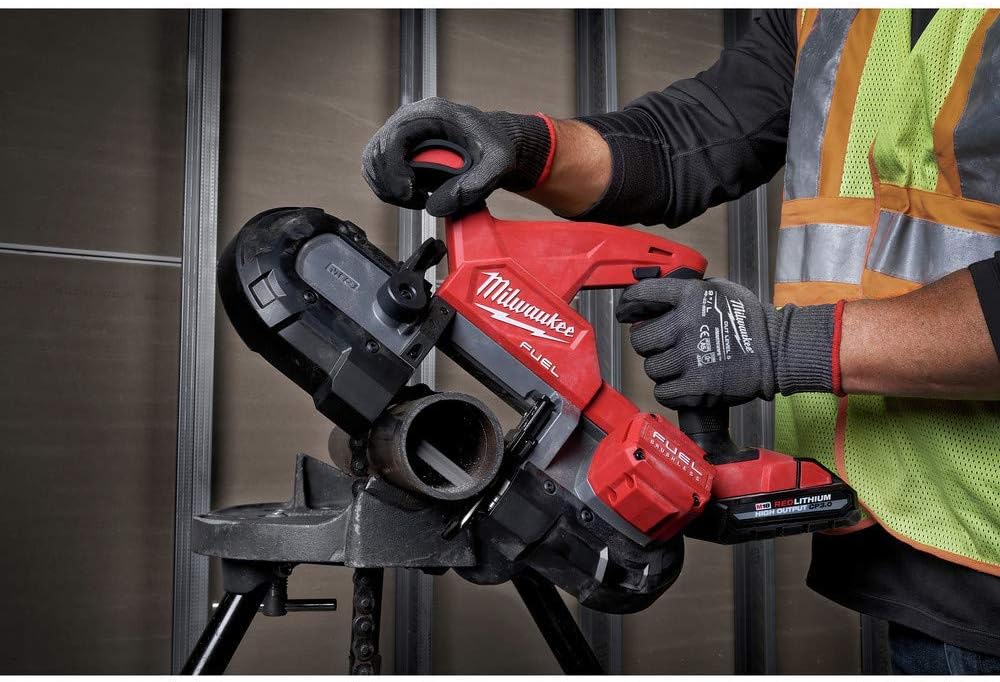A band saw is a versatile power tool used in woodworking, metalworking, and other industries for cutting straight and curved lines in various materials, including wood, metal, plastic, and food.
Its applications include straight cuts, curved cuts, resawing, veneer cutting, metal cutting, food processing, and more. Band saws are valued for their precision and ability to handle intricate cutting tasks in a variety of fields, from construction to artistic craftsmanship.
What Is the Purpose of a Band Saw?
The purpose of a band saw is to effortlessly and precisely cut through various materials, making it an indispensable tool in woodworking, metalworking, and beyond.
Definition and Components of a Band Saw:

A band saw is a versatile power tool used for cutting various materials, primarily wood, metal, and plastic. It operates using a continuous band of toothed metal that revolves around two wheels, allowing for precise and controlled cutting.
Components of a Band Saw:
Frame: The frame provides the structural support for the entire machine. It determines the size and stability of the band saw.
Table: This is the flat working surface where materials are placed for cutting. It can be adjusted for angle and height.
Blade: The blade is the heart of the band saw. It consists of a continuous loop of teethed material, which varies in size and tooth configuration depending on the material to be cut.
Blade Guides: These guides keep the blade in place, preventing it from wandering off the wheels. They consist of upper and lower guides.
Wheels: The upper and lower wheels are responsible for driving the blade. The upper wheel is usually adjustable to change the blade tension.
Motor: The motor provides the power necessary to rotate the wheels and drive the blade.
Fence and Miter Gauge: These accessories help guide the material during straight and angled cuts.
Dust Collection System: Many band saws come with a dust collection port to keep the workspace clean.
Types of Band Saws (Horizontal and Vertical):
| Aspect | Horizontal Band Saws | Vertical Band Saws |
| Orientation | Horizontal | Vertical |
| Blade Movement | Horizontal | Vertical (Up and Down) |
| Common Usage | Metalworking shops | Woodworking (and metal with appropriate blade) |
| Cutting Capability | Excellent for straight cuts and thick metal stock | Versatile for intricate curved cuts |
| Maneuverability | Limited maneuverability | Greater maneuverability for curved cuts |
| Typical Applications | Large, heavy workpieces | Intricate curved cuts, woodworking tasks |
| Blade Options | Specific to metal cutting | Versatile for various materials with different blades |
| Precision and Accuracy | High precision for straight cuts | Good precision for curved and intricate cuts |
What Are the Primary Applications of a Band Saw?
The primary applications of a band saw span across woodworking, metalworking, and more, as it excels in tasks like curved cuts, resawing, and intricate designs.
Woodworking Applications:
Straight Cuts: Band saws are widely used in woodworking for making precise and clean straight cuts. This is especially useful for tasks like cutting lumber into smaller pieces for building projects or creating joinery.
Curved Cuts: One of the standout features of a band saw is its ability to make intricate curved cuts. Woodworkers use band saws to create ornate designs, scrollwork, and irregular shapes in wood that would be challenging with other saws.
Resawing: Resawing involves cutting a thick board into thinner boards or veneers. Band saws excel at this task, producing smooth and consistent results. Woodworkers use resawing to create bookmatched panels, veneers for fine furniture, and more.
Metalworking Applications:
Metal Cutting: Band saws equipped with the appropriate metal-cutting blades are indispensable in metalworking shops. They can cut through various types of metal, including steel, aluminum, and brass, with precision and minimal waste.
Metal Shaping: Band saws can be used for shaping metal pieces, such as cutting curves or notches. This is particularly useful in metal fabrication and custom metalwork, where intricate shapes are required.
Meat Cutting and Food Industry Uses:
Band saws are commonly used in the food industry, especially in butcher shops and meat processing facilities, for tasks like:
- Meat Slicing: Band saws are ideal for cutting large meat cuts into smaller, more manageable portions.
- Bone-in Meat Cutting: They can cut through bone, making it easier to prepare bone-in cuts like steaks and chops.
- Frozen Food Cutting: Band saws equipped with special blades can cut through frozen foods without damaging them.
Final Thought
In conclusion, the band saw is a versatile and indispensable tool with a wide array of applications across various industries and crafts. Understanding its components, types, and common features lays the foundation for safe and efficient use.
From woodworking, where it excels in making straight and curved cuts and facilitating resawing, to metalworking, where it handles metal cutting and shaping with precision, the band saw proves its worth time and again.
In the food industry, it streamlines meat cutting processes, while in specialized fields such as plastics, leatherworking, and foam cutting, it showcases its adaptability.
